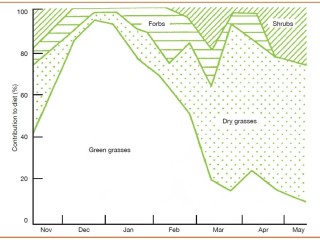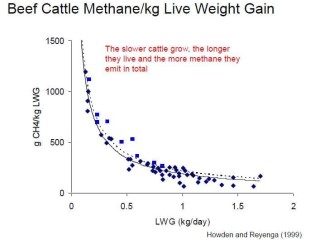 Under the Carbon Farming Initiative passed by the Senate this week, primary producers will have two options to earn carbon credits – by reducing greenhouse emissions or through bio-sequestration. Founder of the Carbon Grazing principle Alan Lauder believes the one that will have the most appeal to livestock producers will be methane reduction – and he argues that producers can acheive this without reducing profits. Here's how:
Under the Carbon Farming Initiative passed by the Senate this week, primary producers will have two options to earn carbon credits – by reducing greenhouse emissions or through bio-sequestration. Founder of the Carbon Grazing principle Alan Lauder believes the one that will have the most appeal to livestock producers will be methane reduction – and he argues that producers can acheive this without reducing profits. Here's how:
What is made available for cattle and sheep to eat, determines the amount of methane they produce. There is a relationship between methane emissions and feed digestibility.
How quickly the grass passes out of the first stomach (called the rumen), determines the amount of methane produced. The rumen has millions of micro-organisms in it that break down what the cow eats. It is a bit like a fermenting vat. The cow is relying on these micro-organisms to keep reproducing and keep breaking down what it has eaten. It is when the micro-organisms reproduce slowly, that we have a problem with both animal growth and increased methane production.
Like all forms of life, these micro-organisms have to build their little bodies. Like us, they need protein. If there is not enough protein in a cow’s diet, then the microbes reproduce slower.
The amount of protein available is determined by the level of nitrogen in the diet of the cow. To determine protein content, just multiply measured nitrogen by 6.25. Plant carbon levels remain constant, it is the nitrogen level that varies. A lot of you know this as the carbon:nitrogen ratio.
To increase digestibility, increase the nitrogen content of your pastures. A leaf has a higher nitrogen content than the stem, which is why it is more digestible.
How steers selected their diet at Alice Springs
 The graph (cattle diet selection Alice Springs) demonstrates how planting shrubs is one way to reduce methane emissions (planting fodder trees like leucaena will have the same positive outcome). The graph highlights that cattle were selecting different plants as the season changed, to maximise their nitrogen (protein) intake. When green grass was in short supply, they sourced nitrogen from the shrubs. A slight increase in the availability of green grass in April, lead to a decrease in the consumption of shrubs, as shown at the top of the graph i.e. the cattle were able to source more protein via the green grass, so relied less on the shrubs.
The graph (cattle diet selection Alice Springs) demonstrates how planting shrubs is one way to reduce methane emissions (planting fodder trees like leucaena will have the same positive outcome). The graph highlights that cattle were selecting different plants as the season changed, to maximise their nitrogen (protein) intake. When green grass was in short supply, they sourced nitrogen from the shrubs. A slight increase in the availability of green grass in April, lead to a decrease in the consumption of shrubs, as shown at the top of the graph i.e. the cattle were able to source more protein via the green grass, so relied less on the shrubs.
Nitrogen content drives digestibility and unless the digestibility of the feed can be maintained above about 50%, then methane emissions will skyrocket.
Edible shrubs are the most resilient of the perennials and are responsible for improving the carbon:nitrogen ratio of the total diet under adverse conditions. In other words, they improve the digestibility of the diet by supplying long term protein to go with frosted or dry old grass. They transfer the use of rain further in the future.
The rumen microbes rely on shrubs and fodder trees to build their bodies. Then they can break down poor quality (low protein) grass and empty the rumen quicker.
Australia has the most variable climate in the world. Reducing the effect of seasonal variability is the best way to reduce methane emissions. Perennials are less affected by seasonal variability than annuals. This is why maintaining the percentage of perennials, be they grasses or shrubs, is so important.
The relevant debate
The methane debate is one of subtleties, with the true issue being the production of methane “per kg of production”. What can cause confusion is that with a more digestible diet, the rumen empties quicker. This means the cow can go and have another feed sooner. The result is that more methane is produced per day, however, the animal gets to the slaughter house in a lot fewer days. It is the total amount of methane produced to reach a given weight that matters (see below graph which highlights higher methane per kg of production when growth rate slows).
 It is in drought, that methane production per kg of production goes through the roof. In a dry time, the animal is sitting there producing methane every day for little growth. The fact that a cow produces less methane per day during dry spells is not the point.
It is in drought, that methane production per kg of production goes through the roof. In a dry time, the animal is sitting there producing methane every day for little growth. The fact that a cow produces less methane per day during dry spells is not the point.
A simulation was done using data from the Wongan Hills site in Western Australia. The sheep were kept in a Score 1 condition and gained only half a kilogram for a year. This of course, closely approximates drought conditions. In this situation, the sheep emitted nine times more methane per kg of live weight gain than they would in better conditions.
As an ongoing source of protein, perennial saltbushes are responsible for maintaining a more balanced rumen and lower methane emissions per kg of production, by leveraging low protein grass.
Win/win
Reducing methane per kg of production is a positive message, as it requires the same management as increasing profits i.e. getting animals to the meatworks as quickly as possible. Put simply, the major strategy for reducing methane production is also the key driver of profit in grazing – reducing the number of grazing days per kg of product.
It has been known for many years that methane production represents poor conversion of food to energy and, as such, is a waste gas.
Breeders
Given that breeders are not sent off to market the way slaughter cattle are, the best way to lower their emissions per unit of production, is to increase the reproduction rate. This again comes back to the digestibility of their diet as it influences the conception rate. Their success in rearing offspring also depends on the digestibility of their diet.
In the event of “true” methane emissions being taxed, there would be a need to think long and hard about feeding animals in a drought. Many people currently feed to keep animals alive i.e. no weight gain. Now producers would be paying a methane tax as well as a fodder bill for no weight gain.
Carbon Farming Initiative
Methane emissions from cattle and sheep have been a topical and emotive discussion for some time. While nobody knows what the future holds, the political process is currently not intending to hold livestock producers liable for these emissions. With the introduction of the Carbon Farming Initiative (CFI), producers who can demonstrate that they have reduced methane emissions will be rewarded via the carbon credit process.
A carbon credit is a legal contract to supply an outcome. The second aspect is the need for permanence i.e. the outcome does not reverse in the future. At the moment, the permanence clause has a 100 year requirement.
This permanence clause is why a management change that reduces emissions of a greenhouse gas has an advantage over biosequestration. Biosequestration is removing carbon dioxide from the atmosphere and storing it in a sink such as trees or the soil. Emission reductions are final and can’t reverse, while biosequestration is part of the carbon cycle and can reverse. Soil can lose stored carbon and trees can return carbon to the atmosphere by burning.
One proposed offset under the CFI is management changes to reduce methane emissions from livestock. This is low risk to rural producers, as this outcome will never reverse. The other practical aspect of credits based on methane emission reductions, is flexibility with offset duration.
Methane offset credits could be used to help fund planting of leucaena and saltbush, to develop reliable production systems consistent with our unreliable climate.
Alan Lauder is the founder of the Carbon Grazing principle and author of “Carbon Grazing – the missing link” Click here to visit his website.



HAVE YOUR SAY